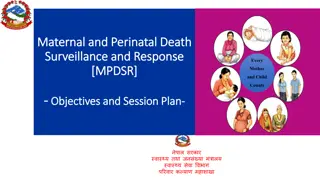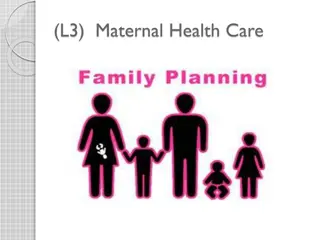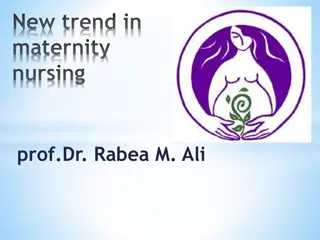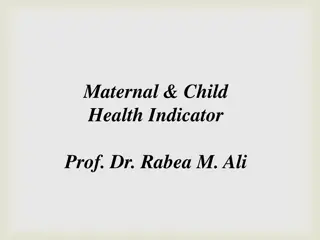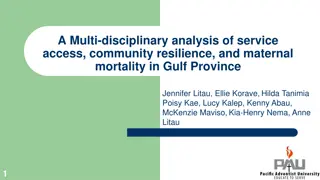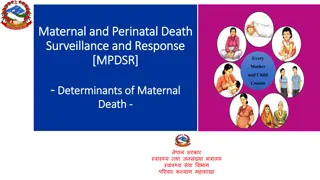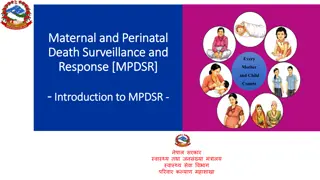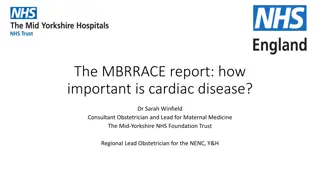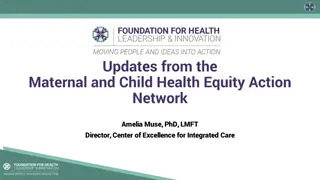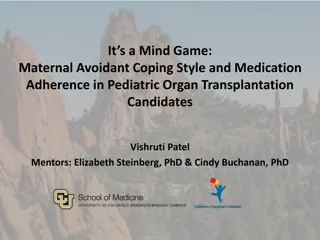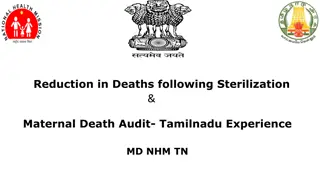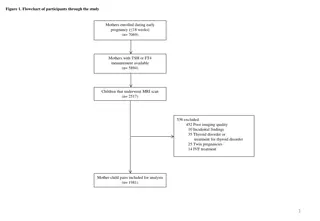Maternal & Child Health: Understanding and Addressing Health Behaviors and Risks
Explore the critical aspects of maternal and child health, such as factors affecting pregnancy, maternal mortality, preconception health care, and ways to improve the well-being of women, infants, and children. Understand the social and physical determinants impacting maternal and child health and learn how skilled care can save lives. Raise awareness about preventable causes related to pregnancy complications and childbirth, emphasizing the importance of access to proper health services for women and families.
Download Presentation

Please find below an Image/Link to download the presentation.
The content on the website is provided AS IS for your information and personal use only. It may not be sold, licensed, or shared on other websites without obtaining consent from the author. Download presentation by click this link. If you encounter any issues during the download, it is possible that the publisher has removed the file from their server.
E N D
Presentation Transcript
Maternal & Maternal & Child Health Health Child Student Led Seminar FMED 421 By: Feras AL-Fawaz Ali ALElayan Musab ALMasry
Objectives Health behaviors and health systems indicators that affect the health, wellness, and quality of life of women, children, and families. Factors can affect pregnancy and childbirth, including: Preconception health status, Age, Access to appropriate preconception and interconception health care, Poverty Health risks may include: Hypertension and heart disease, Diabetes, Depression, Genetic conditions, Sexually transmitted diseases (STDs), Tobacco use and alcohol Abuse, Inadequate nutrition, Unhealthy weight Social and Physical Determinants of Maternal Health Social and Physical Determinants of Infant and Child Health How to improve the health and well-being of women, infants, children, and families.
What is Maternal health What is Maternal health Maternal health refers to the health of women during pregnancy childbirth and the postpartum period. for too many women it is associated with suffering, ill-health and even death
830 women die from preventable causes related to pregnancy and childbirth Every day !!! Maternal mortality is higher in women living in rural areas and among poorer communities. 99% of all maternal deaths occur in developing countries. Young adolescents face a higher risk of complications and death as a result of pregnancy than other women. Skilled care before, during and after childbirth can save the lives of women and newborn babies.
Maternal Mortality Ratio Maternal death is the death of a woman while pregnant or within 42 days of termination of pregnancy. All maternal deaths occurring within a reference period (usually 1 year) x100,000 ______________________________________________________ Total # of live births occurring within the reference period
Preconception Health Care Preconception Health Care Preconception health care : is the medical care a woman or man receives from the doctor or other health professionals that aimed to increase the chance of having a healthy baby. - Should ideally take place 3-6 months before cnception. # Is it only for woman ? # What are the items that coverd by Preconception Health Care ?
Items Items coverd coverd by Preconception Health Care by Preconception Health Care Minimizing occupational risks. Prescribing folic acid Control and treat underlying medical conditions Maximizing chronic illness care Improving health habits Review current medications and assess safety Vaccinations Genetic screening
Carrier Screening Carrier Screening - Examples include sickle cell disease in blacks and Tay-Sachs disease in Ashkenazi Jews and Eastern Europeans called carrier screening. - current recommendations state that all women should be offered carrier screening for cystic fibrosis.
Prenatal care Prenatal care Is the care a woman gets during pregnancy. : During the First Visit probably sometime after the eighth week of pregnancy. Most health care providers won t schedule a visit any earlier unless you have a medical condition,
: Routine Prenatal Tests Routine Prenatal Tests Urine sample for infection and to confirm your pregnancy. Blood pressure, weight, and height. Prenatal blood tests Complete physical exam, including a pelvic exam. Gonorrhea and chlamydia cultures, and Pap test to screen for cervical cancer. Ultrasound test.
Factors Affecting Pregnancy Factors Affecting Pregnancy Existing Health Conditions Age Conditions of Pregnancy Lifestyle Factors
High risk Factor in maternal and child health HTN Heart Disease GDM Tobacco &alcohol use STDs Nutrition Unhealthy weight Genetic factor Post partum depression
Hypertension Hypertension most common medical problem encountered during pregnancy, complicating 2-3% of pregnancies complication: preeclampsia : (proteinuria) , usually after 20 weeks of pregnancy BP and signs of damage to another organ system Failure to thrive, seizures, , lack of energy, and difficulty in breathing can be associated with hypertension in neonates Why is high blood pressure a problem during pregnancy? Decreased blood flow to the placenta Premature delivery Future cardiovascular disease Placental abruption
Heart disease Heart disease Leading to Cause death of maternal heath worldwide Myocardial inarction cardiomyopathy Rheumatic heart disease
Gestational Diabetes mellitus Gestational Diabetes mellitus is when a woman without diabetes, develops high blood sugar levels during pregnancy Approximately 7% of all pregnancies are complicated by GDM more than 200,000annually. in gestational diabetes, blood sugar usually returns to normal soon after delivery. But you're at risk for type 2 diabetes. Risk factors? Family or personal health history. Age greater than 25 Excess weight (30 or higher BMI)
complication complication mother baby Preterm birth with respiratory distress syndrome preeclampsia birth weight Future DM Blood sugars
Tobacco use Tobacco use Approximately 10% of women reported smoking during the last 3 months of pregnancy. Tobacco effect: hard to get pregnant Miscarriage problems with the placenta Risk for Sudden Infant Death Syndrome (SIDS) cleft lip or cleft palate
Alcohol Alcohol use use There is no known safe amount of alcohol use during pregnancy.
STDs STDs 1 1- -HIV/AIDS HIV/AIDS It recommends that all women who are pregnant or planning to get pregnant should get tested for HIV as early as possible. If a woman is treated for HIV early in her pregnancy, the risk of transmitting HIV to her baby can be 1% or less. How to lower their risk of transmitting HIV to their babies? Take HIV medicines After delivery, ensure their infants take HIV medicines Avoid pre-chewing food for an infant, toddler, or anyone else. Avoid breastfeeding
2 2- -Herpes Herpes Herpes is safe in pregnant women until she get ready to deliver. Herpes lesions on genitals are highly contagious and infect the baby during labor 3 3- -syphilis syphilis May be transmitted to baby by infected mother. It be linked to premature birth, stillbirth ,death in some cases 4 4- -Gonorrhea Gonorrhea The risk in pregnancy :miscarriage, preterm birth The risk before and after pregnancy if untreated : cause pelvic inflammatory disease Gonorrhea in newborns most commonly affects the eyes
Hepatitis Hepatitis The risk of a pregnant woman passing the to her unborn child has been related RNA levels in her blood, and HIV positive. can be spread to a baby during childbirth In highly endemic areas, hepatitis B is most commonly spread from mother to child at birth perinatal transmission Transmission of the virus to the fetus HCV RNA titer greater than 1 million copies/mL Mother without HCV RNA , no Transmission When babies become infected they have a 90% chance of developing a lifelong, cause liver damage, liver disease, and liver cancer. HBIG shot and the first dose of Hepatitis B vaccine within 12 hours of being born. CDC recommends that babies get the There is no preventive treatment can influence the transmission.
Poor nutrition Poor nutrition mother baby fail to gain weight in pregnancy low-birth weight malnutrition Mother die while pregnant restricted foetal growth type 2 diabetes Iron : Preterm birth Neurological dysfuction risk of death from bleeding during childbirth Vit A: night blindness Folate : neutral tube defect Micro nutrition Calcium : poor skeletal development Iron: low birth weight
Unhealthy weight Unhealthy weight A women weight before and during pregnancy are important indicators of health for both mother and child. Recent CDC studies showed overweight or obese before pregnancy associated with a higher pregnancy complication. Genitic Genitic conditions conditions more than 50 per cent of miscarriages in the early stages of pregnancy are due to abnormalities of the chromosomes. Down's syndrome: have two number of 21 chromosome , low IQ Sickle cell, G6PD, heamophilia
Postpartum depression Postpartum depression 1 in 9 women experience depression before, during, or after pregnancy Symptoms : Crying more often than usual. Feelings of anger. Withdrawing from loved ones. Risk Factor: Stress. Low social support Preterm (before 37 weeks) labor and delivery. Having a baby with a birth defect or disability.
Social and Physical Determinants of Maternal Social and Physical Determinants of Maternal and child Health and child Health range of biological, social, environmental, and physical factors have been linked to maternal, infant, and child health outcomes. These include: race and ethnicity, age, and socioeconomic factors, such as income level, educational attainment, medical insurance coverage, access to medical care, pre-pregnancy health, and general health status.
How to improve maternal and child health How to improve maternal and child health approximately 830 women die every day from causes related to pregnancy and childbirth. 5.9 million children under age five died in 2015, 16000 every day. With quality health care, many of these deaths could be prevented.
Postnatal Care Highlights Postnatal Care Highlights Provide postnatal care in first 24 hours for every birth: Delay facility discharge for at least 24 hours. Visit women with home births within the first 24 hours. Provide every mother and baby four postnatal visits on : First day (24 hours), Day 3 (48 72 hours) , Between days 7 14 and the Sixth week.
How to improve Maternal health How to improve Maternal health First 24 hours : assessment of vaginal bleeding, uterine contraction, temperature and heart rate should be done routinely during the first 24 hours Breastfeeding should be assessed women should be asked about their emotional wellbeing, what family and social support they have After 10 14 days, all women should be asked about postpartum depression
How to improve Maternal health How to improve Maternal health All women should be asked about sexual intercourse and possible dyspareunia as part of an assessment of overall well-being 2 6 weeks after birth Iron and folic acid supplementation should be provided for at least 3 months after delivery.
How to improve infancy health How to improve infancy health promote early and exclusive breastfeeding (EBF): Evidence shows EBF reduces the risks of mortality and morbidity and improves post- neonatal outcomes Preterm and low-birth-weight babies should be identified as soon as possible and should be provided special care. A full clinical examination should be done 1 hour after birth. This includes giving vitamin K prophylaxis and hepatitis B vaccination (within 24 hours).
How to improve maternal and child health How to improve maternal and child health Vaccinations : Before pregnancy: measles, rubella During pregnancy: tdap vaccine to protect against whooping cough To the infant: hepatitis B, TB, Chickenpox -- Flu shot could be taken during or before pregnancy.
Vaccinations pregnancy infant During Before Measles rubella hepatitis B TB Chickenpox tdap vaccine to protect against whooping cough Flu shot could be taken during or before pregnancy
How to improve maternal and child health How to improve maternal and child health Lifestyle modification: smoking, drinking alcohol Avoid stress Nutrition support Sanitation
Answers What is the newborn normal weight ? A- 2.5 kg B- 1.5 kg C- 6 kg
Answers Which one of the following vaccines should be given immediately after birth ? A- Hepatitis B B- Varicella C- Hepatitis A
Answers Which of the following is a maternal health indicator recommended by WHO? A- Sexually transmitted infections (STIs) incidence rate B- Cervical cancer screening C- Skilled attendant at birth
Answers What s the Maternal mortality ratio in Saudi Arabia in 2015? A- 12 Per 100,000 live births B- 24 Per 100,000 live births C- 48 Per 100,000 live births
Answers What is the most common medical problem encountered during pregnancy? A- Hypertension . B- DM. C- UTI.
http://apps.who.int/gho/data/view.sdg.3-2-data-ctry?lang=en http://www.who.int/topics/maternal_health/en/ http://www.who.int/woman_child_accountability/progress_information/recommendation2/en/ http://www.who.int/gho/countries/sau/country_profiles/en/ http://www.who.int/gho/child_health/en/ http://www.who.int/maternal_child_adolescent/publications/WHO-MCA-PNC-2014-Briefer_A4.pdf?ua=1 http://www.who.int/mediacentre/factsheets/fs178/en/ http://www.who.int/mediacentre/factsheets/fs348/en/ http://www.who.int/mediacentre/factsheets/fs290/en/ http://www.who.int/topics/millennium_development_goals/maternal_health/en/ http://www.cdc.gov/preconception/planning.html https://www.nichd.nih.gov/health/topics/preconceptioncare/conditioninfo/pages/prenatal-visits.aspx https://www.healthypeople.gov/2020/leading-health-indicators/2020-lhi-topics/Maternal-Infant-and-Child-Health/determinants



